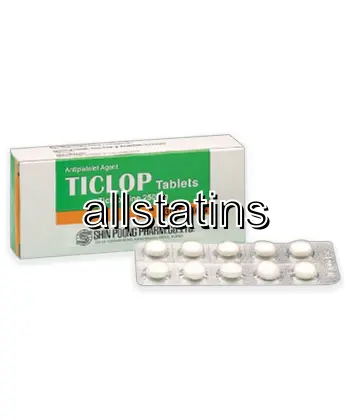Buy Ticlopidine Online in the USA at All Statins
| Package | Dosage | Price | Price per Dose | |
|---|---|---|---|---|
| Dosage: 250mg | ||||
| 180 pill | 250mg | $1,126.61 | $6.26 | |
| 120 pill | 250mg | $825.22 | $6.87 | |
| 90 pill | 250mg | $681.70 | $7.57 | |
| 60 pill | 250mg | $500.51 | $8.34 | |
| 30 pill | 250mg | $287.02 | $9.56 | |

Ticlopidine Description
Introduction to Ticlopidine
Ticlopidine is an oral medication primarily used to prevent blood clots and reduce the risk of stroke in patients with a history of cerebrovascular disease. It belongs to the class of drugs known as antiplatelet agents, which work by inhibiting platelets from clumping together. This action helps to maintain blood flow and prevents blockages in arteries, reducing the likelihood of ischemic events.
Mechanism of Action
The medication works by irreversibly inhibiting the P2Y12 ADP receptor on platelets. This inhibition prevents the activation of platelets and subsequent aggregation. As a result, ticlopidine decreases the formation of blood clots that can lead to strokes, heart attacks, and other serious vascular conditions. Its effect on platelet aggregation makes it a valuable tool in secondary prevention for individuals at high risk of clot-related events.
Usage and Dosage
Ticlopidine is typically prescribed as a daily oral dose, often divided into two doses to ensure steady blood levels. The usual starting dose is around 250 mg twice daily, but this can vary depending on individual patient factors and clinical judgment. It is generally recommended to continue treatment for as long as the benefits outweigh the risks, especially in patients with a history of thrombotic events. Patients should follow their healthcare provider's instructions carefully and attend regular monitoring appointments.
Potential Benefits
These include a significant reduction in the occurrence of ischemic strokes and other thrombotic complications. Ticlopidine has been found particularly useful when patients are intolerant or allergic to other antiplatelet medications like aspirin or clopidogrel. Its ability to effectively inhibit platelet aggregation makes it an important option in secondary stroke prevention strategies.
Possible Side Effects and Risks
Though effective, ticlopidine can cause adverse reactions. Common side effects include gastrointestinal discomfort, diarrhea, and headache. More serious but less frequent effects involve blood disorders such as neutropenia, thrombocytopenia, and aplastic anemia. Because of these potential blood-related issues, regular blood monitoring is essential during therapy. Rare but severe adverse events can include liver toxicity and hypersensitivity reactions. Patients should report any unusual symptoms such as fever, sore throat, or bleeding immediately to their healthcare provider.
Precautions and Interactions
Before starting ticlopidine, patients should inform their healthcare provider about any existing health conditions, especially bleeding disorders, liver problems, or kidney issues. Concomitant use of other blood-thinning agents, NSAIDs, or medications that affect clotting increases bleeding risk. Caution is advised when performing activities that could lead to injury. Alcohol consumption should be limited during treatment to decrease side effects and complication risks.
Conclusion
Ticlopidine remains an important medication in the realm of antiplatelet therapy. Its capacity to prevent clot formation makes it valuable for specific patient populations, especially those intolerant to other therapies. However, due to its potential for serious side effects, careful patient selection, dose management, and regular monitoring are crucial for safe and effective use. If prescribed, adherence to medical guidance ensures optimal benefits while minimizing risks associated with this medication.
